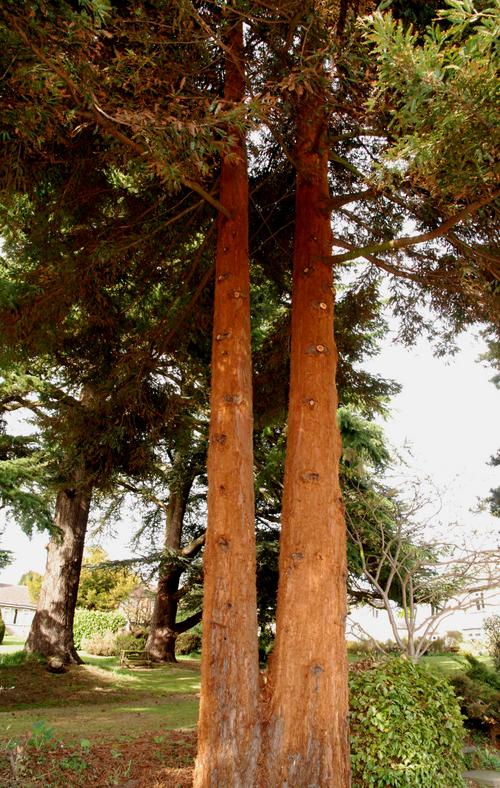Grey Squirrels (Sciurus carolinensis Gmelin) debarking a mature coast redwood (Sequioa sempervirens Endlicher) in Evesham town, Worcestershire during the 2010-2011 winter
P.F. Whitehead
During March 2011 my attention was drawn to the fact that Grey Squirrels Sciurus carolinensis had debarked an ornamental Coast Redwood Sequoia sempervirens of Victorian age in Evesham town, Worcestershire. When I visited the site I observed, quite remarkably, that the outer layers of the outer bark had been removed for the entire height of the twin-stemmed tree (Fig. 1.) estimated to be in the order of 16 metres. The bark removals that littered the ground varied from about 3 cms in length to long strips some 30 cms long and up to 2.5 cms thick. Observers noticed that the squirrels were active during February 2011 and were concerned that the tree might in some way be impacted on. Providing there is no repetition that can be dismissed.
I have no previous experience of Grey Squirrels intensively debarking trees in the family Taxodiaceae, certainly not in this area. Normally Grey Squirrels debark trees which are relatively thin-barked or sappy to gain access to nutrients, especially in the phloem. It is well-known that Sycamore Acer pseudoplatanus L. is favoured, especially when the sap is rising in the spring, and that most British Sycamore woodlands are affected. The question remains as to why Grey Squirrels would debark a Coast Redwood tree so intensively when the tannin-rich bark is stringy, fibrous, has no food value, and would scarcely impact on incisor tooth condition.
Coast Redwoods have a highly developed ability to reproduce themselves vegetatively; it is not infrequent to observe mature trees surrounded by basal suckers, which are able to develop into new trees when the parent tree ages. Buried deep in the outer bark of this tree were numerous semi-dormant adventitious buds, some of which had been exposed. It is contended that the squirrels had actively searched for these by removing the bark systematically and then consumed the developing buds with their rich store of nutrients and auxins. Such damage had not been observed at the site before and it seems probable that this urban population was faced with two choices once their range of food stocks was nearing exhaustion in a severe winter. One was to individually disperse into urbanised surroundings with much more limited available food; the other was to stay put and make creative choices in terms of food resource usage. That is my explanation for why this tree was debarked.
The interlocking history of all these non-native organisms warrants comment. The Grey Squirrel was introduced into Britain sometime around 1828 (Fitter, 1959). The Coast Redwood was introduced into Britain in 1846 (Gilbert-Carter, 1936), i.e. about the same time, although the genus was native in the pre-Pleistocene of Europe. Sycamore is likely to have been introduced into Britain in the early medieval period (Whitehead, 2005). This note is, in essence therefore, a tale of man the unwitting miscreant.
References
Fitter, R.S.R. 1959. The ark in our midst. William Collins Sons & Co. Ltd, London.
Gilbert-carter, H. 1936. British trees and shrubs. Clarendon Press, Oxford.
Whitehead, P.F., 2005. The Coleoptera of Sycamore (Acer pseudoplatanus L.) with reference to Sooty Bark Disease and Bredon Hill, Worcestershire. Entomologist's Gazette 56:107-127
Image
Fig. 1. Mature twin-stemmed Coast Redwood (Sequioa sempervirens) debarked by Grey Squirrels (Sciurus carolinensis), Evesham town, Worcestershire, 31 March 2011. ©Paul Whitehead
